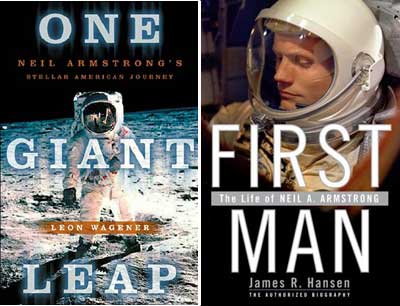Review: two views of the first manby Jeff Foust
|
| However, just because such statements are repeated over and over doesn’t make them true; instead, it’s evidence of what some might call the “mythologizing” of Armstrong. |
One Giant Leap offers what might be called the “conventional wisdom” regarding Armstrong. Journalist Leon Wagener did not have access to Armstrong himself in the course of writing his book, so instead Wagener relied on interviews of people who knew Armstrong, ranging from fellow pilots of the naval fighter squadron Armstrong served in during the Korean War to fellow Apollo 11 astronaut Buzz Aldrin, as well as contemporary press accounts and other documents. While imperfect, it is the best one can do in such circumstances when the subject of a biography is unwilling or unable to cooperate with the biographer.
The result is a book that hews to what is commonly known and accepted about Armstrong: a person who, since a young boy, yearned to travel to the Moon and, once that goal was achieved, retreated to a quiet life in academia and corporate boards. As an example, Wagener cites both a junior high teacher of Armstrong and a local engineer with a home observatory who said that Armstrong, as a child growing up in Wapakoneta, Ohio, that he wanted to travel to the Moon. And who would believe otherwise? After all, someone who ably performed the work and willing accepted the risk involved with such a journey must have been seeking to fulfill a lifelong dream.
Helping debunk that conventional wisdom, at least to some degree, is First Man. Two things set First Man apart from One Giant Leap and other accounts of Armstrong’s life. First is the length and attention to detail. James Hansen, a professor of history at Auburn University, goes into a level of detail, aided by rigorous research, not seen in previous accounts. Not only is First Man more than twice the length of One Giant Leap, it includes notes, a bibliography, and an index that are, combined, more than 100 pages long; One Giant Leap has only a 16-page index.
The second, and more important, factor that sets First Man apart is that it was written with the cooperation of Armstrong, who sat for many interviews with Hansen, providing insights not otherwise available. (While the book is billed as an “authorized biography” of Armstrong, Hansen makes it clear in the acknowledgments section of the book that this is an “independent, scholarly biography” and than Armstrong made no effort to influence Hansen’s interpretation of events.) Hansen also interviewed many other people, including Armstrong’s first wife, Janet, and other family and friends who might not otherwise be available to another biographer.
| “What I tried to do in the book is to give you the Neil Armstrong that really existed,” Hansen said of First Man. |
The result is a comprehensive biography that does as much to bust some of the myths about Armstrong as tell his life story. A case in point is the abovementioned claims that the young Armstrong expressed a desire to go to the Moon. “That’s fiction,” Armstrong bluntly states in the book. “All my aspirations in those days were related to aircraft. Space flight would have been an unrealistic ambition.” Armstrong notes in particular the claims that he spent a lot of time at the home of Jacob Zint, the local engineer with the telescope, were false: he visited the Zint home perhaps once, and never looked through the telescope or talked with Zint about the Moon.
Oft-repeated stories like that “created a false mythology of who Neil Armstrong was,” Hansen said during a stop in Washington last fall during a tour promoting the book. That mythology has been created in part by a society seeking to imprint their own meaning on who Armstrong was and why he traveled to the Moon: a person who flew to the Moon because he had aspired to do so since a child sounds far more noble than a test pilot-turned-astronaut who got to be the first man to walk on the Moon because of his expertise, demeanor, and at least a little bit of luck. “What I tried to do in the book is to give you the Neil Armstrong that really existed,” Hansen said.
Given that Armstrong himself has called First Man a “great book”, according to Hansen, it seems clear that Hansen did succeed, or at least came far closer to describing the real Armstrong than anyone else to date. While this book is not the last word on Armstrong—and one hopes that the final chapter of Armstrong’s life is not written for many years to come—it provides a far better picture of Armstrong the man, rather than Armstrong the icon, than One Giant Leap or previous books, as well-intentioned as they might have been about telling Armstrong’s life story. Great men and their deeds, like Armstrong and his journey to the Moon, are compelling enough to stand on their own, without the need for mythology.
